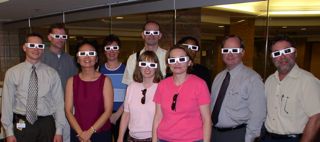The VR gurus at the University of Michigan took us on a short trip into their realm a couple of days ago (just before the power failure!). They demonstrated three viewing options for their VRML files: The Cave, a rear projection screen, and standard web VRML plugins like the Cosmo player.
The Cave is a huge cubical room, about 10 feet on a side, with one wall removed. Each wall is a rear projection screen, except the floor, which gets its image from a mirrored projection unit placed in the ceiling (at least the mirror is - I am not sure where the projection came from.) The offset images are polarized, apparently they are alternated about 100 times a second, so if you view them without glasses, you will see a slightly doubled image. The viewpoint is determined by the "leader" who wears a set of polarized glasses (kind of like Oakleys on steroids) wired into the system. When the leader turns their head, the perspective - and separation of the images - changes to suit them. The glasses have shutters on each eye -they alternate open and shut, in sync with the image. The 3D effect is quite good. Everyone else in the room wears shuttered lenses also, but not wired in, so the viewpoint may be a little off for some. They demonstrated an architectural model of "the Barcelona House", and a human heart.
Ads by Google
Posted by ellen at August 17, 2003 02:09 PM
The second, much more affordable method, originally designed for viewing geological data involved a rear projection screen setup which creates a believable 3D effect on one plane in front of you instead of all around you. A couple of LCD projectors are mounted in a rack, one right above the other. They are each hooked in to a separate graphics card output on a computer (in this case I believe it was a Win2K box). The projectors are about 8-10 feet behind the screen. The exact angle and position of the projectors must be calibrated to suit viewing from a given distance from the front of the screen, about 6 feet. The glasses used are the traditional cardboard 3D glasses: the polarizing type, not the old red/green ones. A more complete description of the "GeoWall" setup is HERE A list of software suggested for this application is
The budget display method is to put the VRML file on a web server, and let your audience download the VRML viewer of choice. There are some plugins listed HERE though I have not tried many of them yet.
We also saw their incredible 3D printer, which works by accreting layers of a fused powder, controlled by 3D data. It is capable of creating freestanding objects within other objects, since it does not work by milling away from a single block of material.
The home page for the UofM virtual reality lab is HERE
Ads by Google
